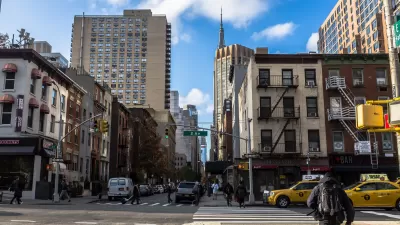Buoyed by a recovering real estate market, and a race to build the tallest and most exclusive residential towers in the city, Manhattan is experiencing a surge in air-rights deals. Robin Finn explores the nuances of this complex market.
Established by New York City with 1916 and 1961 zoning regulations, the sale of air rights, or transfer of development rights (T.D.R.'s), "have become the reigning currency of the redevelopment realm, major components in the radical vertical transformation of [New York City's] skyline," writes Finn. "With Manhattan’s skyscraper-proof bedrock in finite supply and the city’s fixation on housing and envelope-pushing office buildings on the upswing — and also the impetus behind the proposed rezoning of 70 blocks around Grand Central Terminal called Midtown East — the sky is not only the limit, it’s the solution."
"These days developers don’t just tailor their blueprints to the lot they own: they often annex, for fees that can run into the multimillions, the airspace above and around their property," he explains. "The process, essentially an invisible merger of building lots that tranlates [sic] into taller, heftier towers with increased profitability, is emerging from a minislump dictated by the economy."
“The trading of air rights is more prevalent than it’s ever been before,” said Robert Von Ancken, an air-rights expert and appraiser who is the chairman of Landauer Valuation and Advisory Services, “and it’s why you’re seeing these monster buildings springing up all over town. All of these new supertowers that are changing the look of the city’s horizon, they couldn’t happen without air-rights transfers.”
But the explosive trend in building as high as possible isn't without its hazards. “Is the future of the city going to be this series of 200-story towers with stultified buildings in between?” asks Robert A. Jacobs, a land-use specialist and partner at Belkin Burden Wenig & Goldman. “You wonder how this will affect the street life, the trees. You wonder about urban plazas surrounded by 50-story walls: what would grow there, mushrooms?”
FULL STORY: The Great Air Race

Planetizen Federal Action Tracker
A weekly monitor of how Trump’s orders and actions are impacting planners and planning in America.

Restaurant Patios Were a Pandemic Win — Why Were They so Hard to Keep?
Social distancing requirements and changes in travel patterns prompted cities to pilot new uses for street and sidewalk space. Then it got complicated.

Map: Where Senate Republicans Want to Sell Your Public Lands
For public land advocates, the Senate Republicans’ proposal to sell millions of acres of public land in the West is “the biggest fight of their careers.”

Orange County, Florida Adopts Largest US “Sprawl Repair” Code
The ‘Orange Code’ seeks to rectify decades of sprawl-inducing, car-oriented development.

Maui's Vacation Rental Debate Turns Ugly
Verbal attacks, misinformation campaigns and fistfights plague a high-stakes debate to convert thousands of vacation rentals into long-term housing.

San Francisco Suspends Traffic Calming Amidst Record Deaths
Citing “a challenging fiscal landscape,” the city will cease the program on the heels of 42 traffic deaths, including 24 pedestrians.
Urban Design for Planners 1: Software Tools
This six-course series explores essential urban design concepts using open source software and equips planners with the tools they need to participate fully in the urban design process.
Planning for Universal Design
Learn the tools for implementing Universal Design in planning regulations.
Heyer Gruel & Associates PA
JM Goldson LLC
Custer County Colorado
City of Camden Redevelopment Agency
City of Astoria
Transportation Research & Education Center (TREC) at Portland State University
Camden Redevelopment Agency
City of Claremont
Municipality of Princeton (NJ)



























